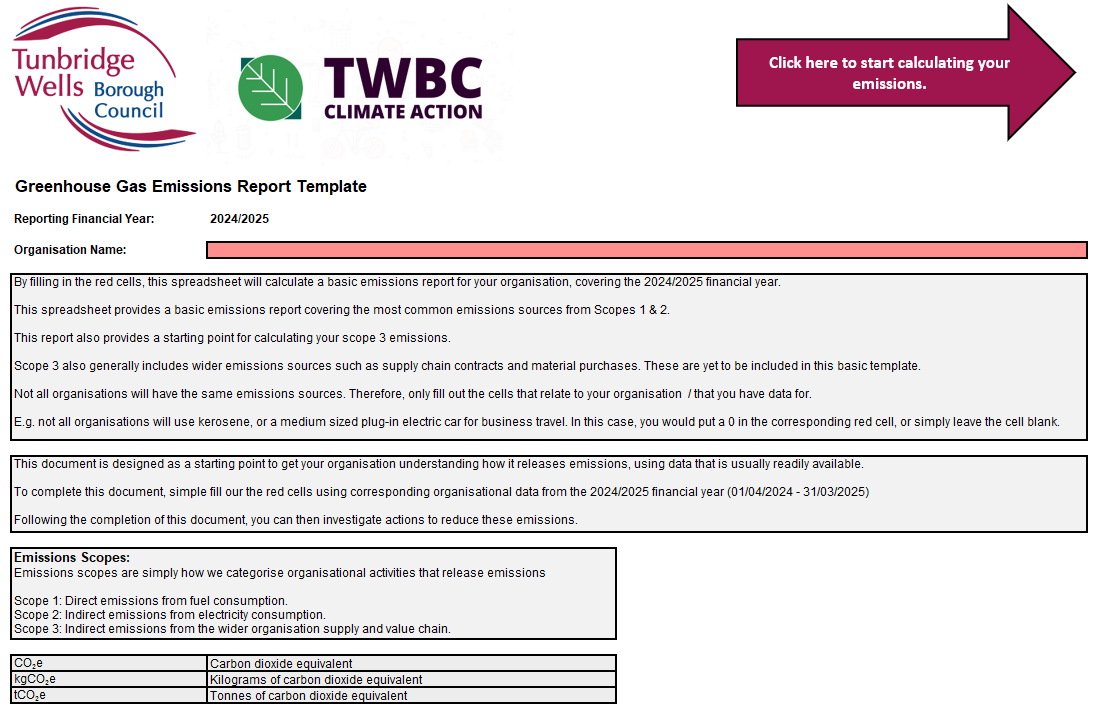Calculating your emissions allows for the identification of a carbon footprint. This is the amount of greenhouse gases (GHG) emissions emitted as a result of your personal or organisation's activities. This covers energy and water use, industrial processes, vehicle use, material purchases and wider supply and value chain.
Why calculate your emissions?
Calculating your emissions is an important first step to allowing a detailed understanding how you or your organisation is contributing to climate change. This allows you to implement plans to reduce them.
Calculating emissions on an annual basis allows you to monitor changes over time and reveals how effective decarbonisation measures have been. If you have set a net zero target, annual emissions calculations will allow you to plot your progress.
How to calculate your emissions?
The below guidance document provides a step by step process to calculating emissions and tracking them over time. TWBC has also developed a basic greenhouse gas emissions report template to provide a simple first step to calculating emissions. This template will be updated annually to include the latest emissions factors.
Developing a Carbon Reduction Plan
The Public Procurement Notice 006 (PPN 006) is in place to require organisations looking to bid on government contracts to have a carbon reduction plan in place and calculate their emissions. Whilst only a requirement for UK Government contracts valued at over £5million, it provides a useful framework for all businesses looking to develop their own carbon descent plans.
Official government guidance and template carbon reduction plans can be found here.
Along with our emissions reporting guidance and template you should have all you need to start pulling together an emissions reduction plan for your organisation.
Streamlined Energy and Carbon Reporting Requirements
If your organisation is a quoted company in the UK, then you will be required to calculate and report emissions in accordance with the Streamlines Energy and Carbon Reporting Requirements (SECR).
As part of an organisations annual directors report filing obligations, organisations must report on the following areas:
- Annual global emissions from activities for which that company is responsible including the combustion of fuel and the operation of any facility; together with the annual emissions from the purchase of electricity, heat, steam or cooling by the company for its own use. This is an organisations Scope 1 and 2 emissions.
- At least one intensity ratio.
- Previous year's figures for energy use and GHG emissions (except in the first year).
- Methodologies used in calculation of disclosures.
- Underlying global energy use that is used to calculate GHG emissions, including previous year's figure (in the first year, previous figures are not required).
- Information about energy efficiency action taken in the organisation's financial year.
- What proportion of their energy consumption and their emissions.
related to emissions and energy consumption in the UK (including offshore area).
You can find the full guidance here.
Useful Resources
- UK Climate Business Hub
- Dedicated resources for business looking to take climate action and be more sustainable.
- Greenhouse Gas Protocol Corporate Standard
- This is the emissions reporting standard our template is based on.
- UK Streamlined Energy and Carbon Reporting Requirements
- Requirements under for SECR for all UK quoted companies.
- DEFRA Emissions Reporting Guidance
- Previous Government guidance on calculating your emissions.
- Small Business User Guide: How to Manage and Report your Greenhouse Gas Emissions
- Tailored guidance for small businesses.





